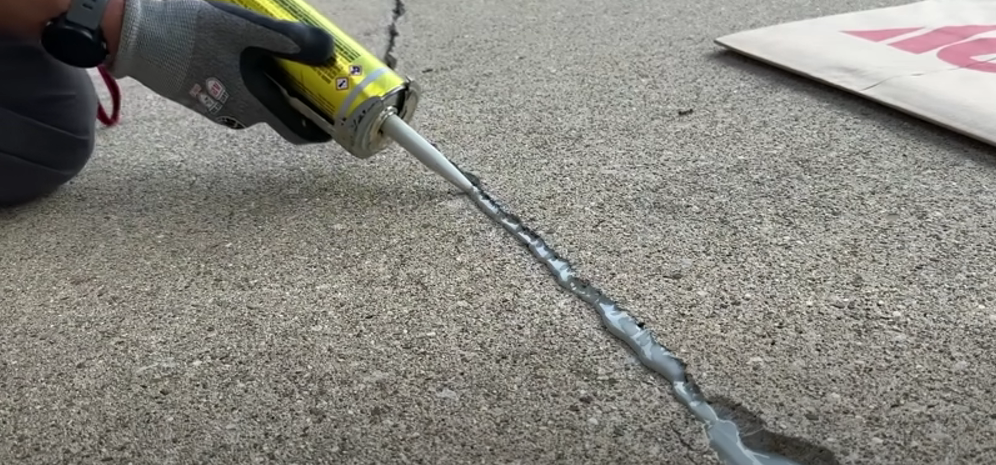A Step-by-Step Guide on
How To Fix Crack in Concrete

Concrete is tough and super versatile—it’s used for everything from driveways and patios to walls and floors. But even the strongest materials can show wear over time, and cracks are pretty common. These cracks can make your concrete look less appealing and, if left alone, might lead to bigger problems down the line. The good news? Fixing them isn’t as hard as you might think! With the right tools, a bit of know-how, and some effort, you can have your concrete looking good as new. These step-by-step instructions should make it easier for you to get started.
Why Do Concrete Cracks Occur?
Before diving into repair methods, it’s important to understand the common reasons why cracks appear in concrete:
- Shrinkage: As concrete dries and cures, it tends to shrink. This shrinkage can lead to small cracks, especially if the mix was too wet.
- Temperature Changes: The expansion and contraction caused by shifts in temperature can create stress that results in cracks.
- Heavy Loads: Overloading concrete with excessive weight, such as vehicles or equipment, can cause cracks over time.
- Poor Installation: Improper mixing, insufficient curing, or inadequate reinforcement can all contribute to cracking.
Assessing the Damage
Before repairing a crack, take time to assess its size and depth.
- Hairline Cracks: These are narrow cracks less than 1/8 inch wide and generally cosmetic.
- Moderate Cracks: Cracks wider than 1/8 inch but not deeper than 1/4 inch may indicate surface-level issues.
- Structural Cracks: Deep and wide cracks could signal underlying problems and may require professional attention.
Tools and Materials You’ll Need
Here’s a list of tools and materials commonly used for concrete crack repair:
- Chisel and hammer
- Wire brush
- Concrete crack filler (epoxy, polyurethane, or patching compound)
- Trowel or putty knife
- Caulking gun (if using a sealant)
- Concrete sealer
- Safety gear (gloves, goggles, and dust mask)
How to Fix Concrete Cracks: A Step-by-Step Process
Follow these steps to effectively repair cracks in your concrete surface:
1. Prepare the Crack
Start by cleaning out the crack to remove debris, dirt, or loose concrete. Use a wire brush or a chisel and hammer to widen the crack slightly, creating a better surface for the filler to adhere to. Finish by blowing out any dust with a blower or vacuum.
2. Choose the Right Filler
The type of filler you use depends on the crack size:
- Hairline Cracks: Use a liquid filler or sealant to ensure proper penetration into the small spaces.
- Moderate Cracks: Apply a concrete patching compound for a stronger repair.
- Structural Cracks: For larger or structural cracks, epoxy injections or polyurethane foam are often recommended.
3. Apply the Filler
- Sealant: If using a sealant, load it into a caulking gun and carefully apply it along the length of the crack.
- Patching Compound: Mix the patching material as directed and use a trowel or putty knife to press it firmly into the crack. Smooth out the surface for a seamless finish.
- Epoxy: For structural repairs, inject epoxy directly into the crack, ensuring it fills the space completely.
4. Allow Time to Cure
Follow the manufacturer’s instructions for curing times. This can range from a few hours to a few days, depending on the filler used.
5. Seal the Surface
After the repair has cured, apply a concrete sealer to protect the surface from future damage. Sealing helps prevent moisture infiltration, which is a common cause of cracking.
Tips for Long-Lasting Repairs
- Start with a clean slate: Make sure the crack is completely clean before you begin. This helps the filler stick better and ensures a stronger repair.
- Pick the right time: Avoid working in extreme heat, cold, or direct sunlight since these conditions can mess with how the filler sets.
- Check regularly: Keep an eye on your concrete surfaces. Catching small cracks early can save you from bigger headaches later on.
When to Call a Pro
If you’re dealing with large, deep cracks or uneven surfaces, it’s a good idea to bring in a professional. These types of issues might point to structural problems that need advanced repair techniques—or even a full replacement..
To Sum It Up
Cracks in concrete are pretty common, but the good news is they’re usually easy to fix if you tackle them early. By following the steps in this guide, you can have your concrete looking great and working like it should. A little regular care goes a long way in keeping it in good shape and saving you time and money later!
LET'S WORK TOGETHER!
Choosing Stevens Point Concrete Experts means choosing a team dedicated to delivering exceptional craftsmanship and superior results. We offer comprehensive concrete solutions, including precise lifting, durable coatings, and stunning decorative finishes, all designed to improve your property's functionality and aesthetic appeal. Our commitment to advanced techniques and high-quality materials ensures that every project meets your highest standards. With a focus on attention to detail and customer satisfaction, we guarantee a smooth, professional experience. Contact us today for reliable service and impressive outcomes. Trust Stevens Point Concrete Experts to bring your vision to life with unparalleled quality and expertise.
QUICK LINKS
COMPANY INFO